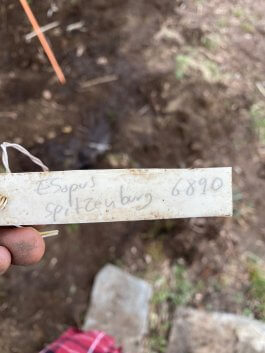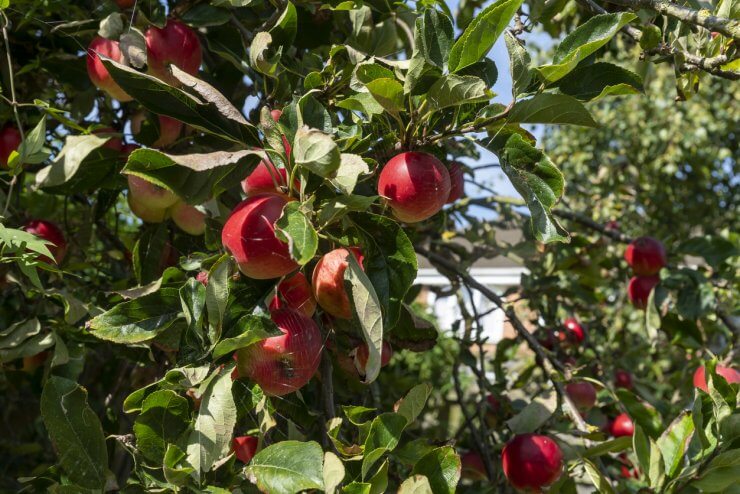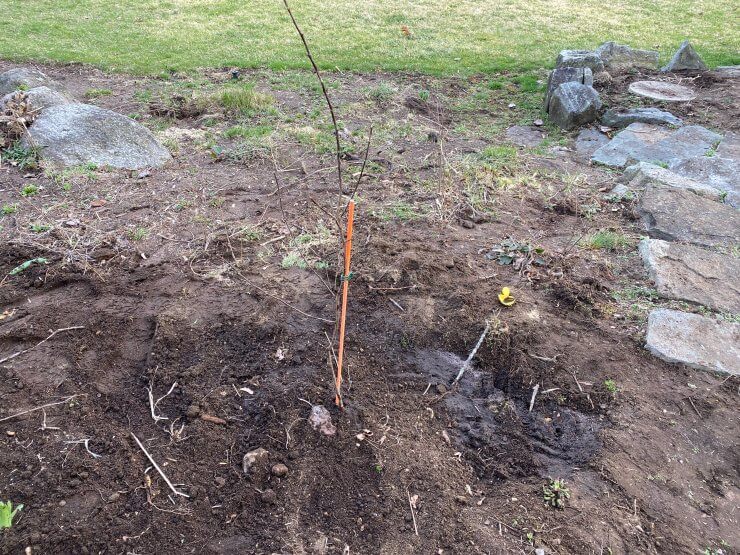
I’ll tell you a secret: The only way you’re going to learn how to plant a bare root apple tree is by … planting a bare root apple tree. Because until you have the fragile bare roots in your hand and have dug the hole in your unique soil, you’re probably going to imagine that planting your tree will be similar to planting a two-gallon bucket apple tree, and it’s quite different. But I have a video and step-by-step instructions to help you get there!
 I was recently fortunate to get my hands on an heirloom Esopus Spitzenburg bare root apple tree from my local botanical garden. Their orchard, which includes 119 heirloom varieties, many very rare, was started during the Great Depression by a man who wanted to make it his life’s mission to preserve heirloom apple varieties. What’s really exciting about the tree I got, is that it’s the same genetic material as the original tree.
I was recently fortunate to get my hands on an heirloom Esopus Spitzenburg bare root apple tree from my local botanical garden. Their orchard, which includes 119 heirloom varieties, many very rare, was started during the Great Depression by a man who wanted to make it his life’s mission to preserve heirloom apple varieties. What’s really exciting about the tree I got, is that it’s the same genetic material as the original tree.
Heirloom apples are rare to come across. These days they’re bred to taste a certain way and travel and store well. They are cross-bred, and apples have lost their genetic diversity due to the need for such specific types of apples. But heirloom apples are not just special in their origins, they taste better too! In fact, I was lucky to get the Esopus Spitzenburg, because only one of every tree was available, and won’t likely be available ever again from the botanical garden, as it was a fundraising effort. I’m lucky because the Esopus Spitzenburg is a coveted apple by chefs everywhere. They’re uncommon to come across, but delicious to cook and bake, and they only get better and sweeter if you store them.
The rootstock on a bare root plant is another fascinating area to learn about. When trees are grafted, the rootstock can be tweaked to help the tree grow and survive better than the prior tree, which doesn’t impact its heirloom-ness. It can also determine if the tree will grow full size, or be semi-dwarf or dwarf.
My Malus ‘Esopus Spitzenburg’ came with a G.890 semi-dwarf rootstock (which sort of feels like I’m describing a car). Some features of the G.890 rootstock:
- Resistant to fire blight
- Resistant to crown rot
- Resistant to woolly apple aphid
- 70-75% in size
- Hardy
- High and early production
Needless to say, getting an heirloom Esopus Spitzenburg is exciting, but at only two years old, it was smaller than other bare root plants I’ve seen planted. A few years ago we planted bare root blueberry bushes and they survived just fine, so I’m optimistic. Since it’s such an undertaking in learning, I wanted to share with you everything I learned from weeks of research, talks with an arborist, and the experts at the botanical garden. The process is quite simple, really, but it’s very specific and much more effort than dropping a bucket of soil with a sapling in the ground.
That said, bare root apple trees grow faster and sometimes better than their bucket counterparts because they’re going directly into the ground they will grow in, rather than having to adjust to new soil from the soil they’re already in.

How to Plant a Bare Root Apple Tree
Spring is the most common time to plant a bare root apple tree, right after the last frost. Naturally, Mother Nature sent some flurries a few days after my baby tree was planted, but the temperature never got below freezing and we didn’t get a frost, so I have high hopes all is well.
Supplies you’ll need:
- A shovel
- A stake & zip-tie (optional)
- Mulch
- Water
1. Prepare ahead. If you’re going to plant a bare root apple tree, just be ready to hit the ground running. Bare root apple trees, and all bare root trees, need to be planted right away. The botanical garden gave us explicit instructions to have our hole dug and ready to go when we got home. Apple trees will want a sunny spot with good drainage that doesn’t get too soggy or too dry.
2. Don’t amend the soil. There’s varying advice on the internet about adding compost and nutrients to the soil, but two of the experts that guided me said you should absolutely not amend your soil. The reason is that when you do, the tree isn’t encouraged to grow roots beyond the amended area. So after they have absorbed all the added nutrients, they can either stop growing or even die. You’re better off planting in the exact soil the tree will be growing in so that they’re forced to search for nutrients and grow more deeply and stronger. If you really feel strongly about adding something, add compost, and mix it in with the existing dirt before spreading. You don’t want the tree to grow in a pocket of compost, or it will act like a barrier that the roots won’t want to venture outside of.
3. Keep your roots bagged until planting, then soak. You don’t want them to dry out or get damaged. One hour to thirty minutes prior to planting, soak your roots in water to prepare them.

The expanded hole wasn’t as photo-ready as the first one.
4. Adjust your hole as needed. Your hole doesn’t need to be deep unless your roots are large, because you’re only supposed to plant as deep as the top root on the trunk. For me, I only had a two-year-old sapling, so it was about six inches deep. However, you should make the hole twice as wide as the roots. When I initially dug the hole, it wasn’t wide enough, so once I saw the roots, I had to make the hole wider. Lucky for me, my roots spread right and left, and not circular, so I just needed to dig a big oval.
5. Inspect your roots. If there are any dead or rotting roots, prune them off with sanitized pruning shears.
6. Prune. The only thing you’ll do by not pruning is you’ll have a wild-looking tree. The benefit of pruning in the first few years is that you can help control what your tree looks like. You want a few strong limbs on an apple tree. Prune off any limbs that are lower than 18″ from the ground. Cut the tips of the branches off at an angle to help the remaining branches grow outward. Prune off limbs that are tight angles to the tree, the wider the angles the better, because you don’t want the limbs to crowd each other when they start fruiting. You can also use “spreaders” to make the angles wider manually.
7. Stake, or don’t stake. If you are planting a bare root tree that is a few years old and stands up confidently after planting, it’s not recommended to stake your tree because it can make it weak with too much support. In the case of my two-year-old sapling, which was little more than a big stick, I chose to stake it because it could have blown over with a few big gusts of wind. Add the stake before you plant so you don’t accidentally jam it down right into the roots.

8. Plant. Plant your tree and cover with the soil from your original hole (or a compost mix mentioned above), only up to the spot you’ll be able to see where the tree was grafted on to the rootstock, which should always be above ground. It will be a bump or joint on your trunk that’s noticeable, and you want it 2-3 inches above ground. Tamp down the soil gently so that it blankets the roots without breaking them.
9. Mulch. Throw down some mulch to keep the sun from drying out your soil that you’re working so hard to keep moist. I used pine bark because I had a bag left over from my blueberry bushes.
10. Fence. If you have critters and rodents that might impact your tree, get a tree cage or a small fence to put around the tree until it’s established.
11. Water. Rather than watering every day, give your tree a deep soak with a hose twice a week to keep the roots moist so they can grow and won’t dry out. This is particularly important the first year, and the second year it will be fairly stress-free and established.
12. Remove blossoms. If your tree blossoms the first year, pop those fellas off. The first year any fruit tree blooms, you should remove the blossoms so that the tree doesn’t stress out trying to develop fruit before it’s strong enough to do so.
That’s it! I can’t wait until my tree begins to fruit in a few years. And somehow I totally lucked out, because as I brought my tree home, I noticed my neighbor is planting six apple trees in his backyard. To pollinate an apple tree, all you really need is a crab apple tree down the street for it to work, and now I’ll have a pack of six right next door. Lucky me!
Best of luck planting your bare root apple tree. Do you feel like you know how to plant a bare root apple tree now? Ask me anything in the comments below.


 Previous
Previous


Getting my first 2 apple trees in the spring: CrimsonCrisp and Pixie Crunch. I plan to prune them to keep them a manageable size, as per Ann Ralph’s book: Grow a Little Fruit Tree. My question is: how far apart should I plant my 2 little trees?